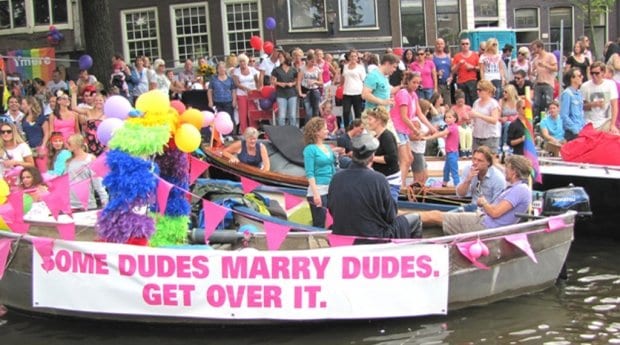
Amsterdam's floating Pride parade on the canal. Credit: Dan Allen
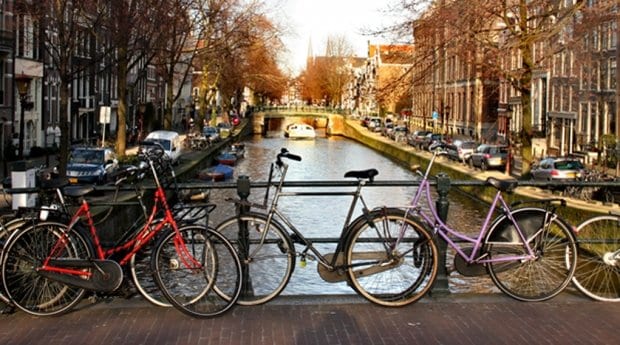
Bicycles are a popular mode of transpotation. Be cautious of the heavy bike traffic flying by as you meander along the canals. Credit: Dan Allen
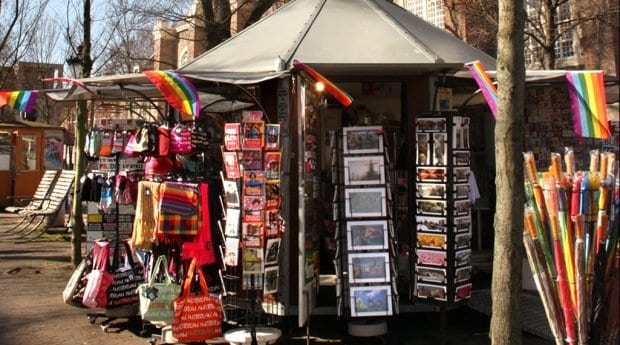
Pink Point at the Homomonument site provides tourist information on gay Amsterdam, touristy items and rainbow chotchkeis. Credit: Dan Allen
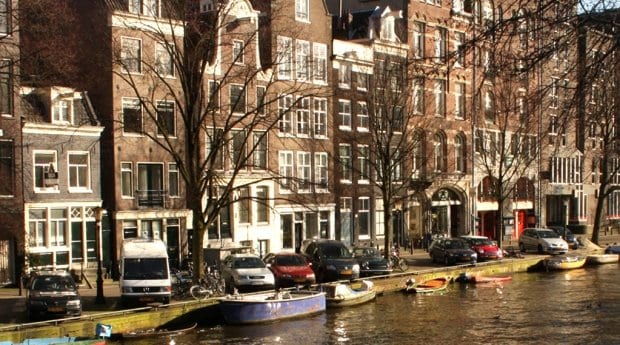
Historic canal houses. Credit: Dan Allen
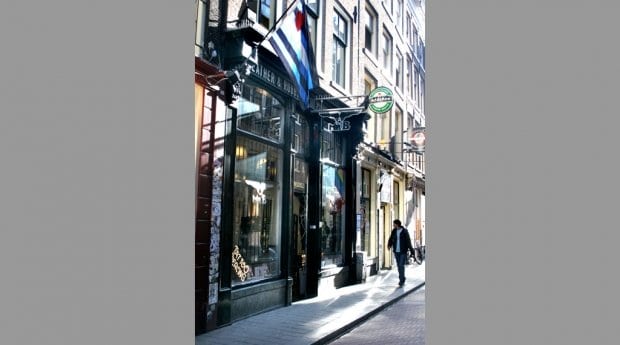
Mr B Leathers is the place for kinksters. Credit: Dan Allen
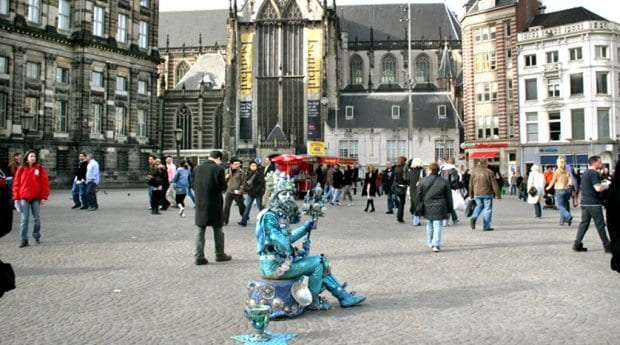
Central plaza is great for people and busker watching. Credit: Dan Allen
In a city as synonymous with LGBT equality as Amsterdam, the question for first-time visitors can be not where to find the queer hotspots, but where to begin?
The Netherlands’ capital is a pretty intimate affair, so finding your bearings is easy. There’s also no real “best part” of the inner city in which to stay for gay nightlife. You’ll find small clusters of bars and clubs throughout the central canal belt, all within an easy 30-40 minute walk from each other. It’s a great way to explore one of Europe’s most enchanting cities at night — one with a queer nightlife tradition dating back almost a century.
Amsterdam is so proud of this fact that it preserves a model of its oldest known gay bar at the Amsterdam Historical Museum (where you can also view the country’s first same-sex wedding rings). Bet van Beeren — eldest daughter in a family of 12 and an out-and-proud admirer of leather, motorcycles and other girls — opened Café t’ Mandje in 1927 on Zeedijk Street. Though she forbade public kissing in her establishment and only allowed same-sex dancing on the queen’s birthday, this was one of the first safe public bars for homosexuals in Europe.
Right up until her death in 1967, van Beeren remained fiercely protective of her bar and her clientele, lighting a porcelain owl behind the bar to forewarn patrons of any suspected homophobes. Her sister Greet continued the tradition until 1982, when the drug-plagued Zeedijk Street became untenable for business. The interior, however, was lovingly preserved, undergoing massive restoration right before Greet’s death in 2007. Greet’s niece, Diana, reopened Café t’ Mandje in 2008, and has managed the tiny bar ever since.
Today’s customers will find it to be a cosy space decked out with memorabilia befitting both its place as an Amsterdam icon and as a bona-fide part of Europe’s gay history. Broader queer life has also returned to Zeedijk Street, including campy watering holes such as The Queen’s Head.
A more contemporary spot is Prik, which serves up delicious cocktails to an easy-going, often mixed, after-work crowd, while its resident alcoholic feline Prikkiedik lounges between them. If you’re bar-hopping in combination with sightseeing, then Prik is the perfect spot for a drink after an hour queuing for the nearby Anne Frank House (a helpful hint: book a timed entry ticket online a few weeks ahead).
A short walk away, you’ll also find the Homomonument on the bank of the Keizersgracht canal, a permanent granite memorial comprised of three pink triangles representing the past, present and future. This is a centrepiece not just for reflection, but for ongoing protest and celebration, connected to gay and trans issues in the Netherlands and worldwide. Inscribed on the monument are words from writer Jacob Israel de Haan, which read “To Such a Friendship Indulgence Desire.”
Right by the Homomonument, the Pinkpoint information centre offers more info about all aspects of Amsterdam’s LGBT life, as well as some uniquely queer souvenirs. You’ll find Amsterdam’s queer bookstore, Boekhandel Vrolijk, in this neighbourhood too.
Back on the bar trail, those travelling through Europe on a budget will probably find themselves swamped with suggestions for “pub crawl” tours. Unfortunately, most of these make a beeline for straight bars, surrounding you with other backpackers. Amsterdam’s solution? Provided you don’t mind hanging out with other tourists (at least at first), the city offers its very own, budget-friendly gay pub crawl that starts at local favourite Taboo, on the easier to find than pronounce Reguliersdwarsstraat.
Through much of the ’90s, this was the heady epicentre of Amsterdam’s gay nightlife, and though it’s lost a bit of its lustre these days, it’s still a worthy stop with plenty of handy dinner options. Most locals, however, prefer to move on before midnight.
Those in search of more typically Dutch bars can cross to the area surrounding picturesque Rembrandtplein, which includes two distinctive local favourites: Vivelavie, which (along with Elandsstraat’s Café Saarein) keeps Amsterdam’s lesbian bar tradition alive; and Lellebel, a tiny drag bar with a DIY approach to having fun. Patrons are encouraged to provide the entertainment themselves, whether it’s with karaoke, quiz night or salsa. It’s a unique space to doll up across the gender divide for some old-school, grassroots queer entertainment.
Amsterdam would be a poor queer capital without its wilder side. While you may not have planned to go to church during your visit, Club Church has, since 2008, happily straddled the lines between dance club, kink, cruising and drag, and is now one of the city’s most popular party spots.
The more traditional fetish and cruising venues, however, are found along Warmoesstraat, in the city’s famed red-light district. You know you’re going to poke your nose through here anyway, especially on a first visit to Amsterdam, so start the night by demolishing one of the famous burgers at Getto and staying for the (live-sung) drag show if it’s in the offing. Then spend an hour or so wandering your way through this infamous, but deservedly iconic, part of Amsterdam before returning to Warmoesstraat. While the rest of the city’s gay scene winds down around 1am, the bars here carry on til 4–5am, so expect some locals to flow to cruising dens such as Eagle and Dirty Dicks.
For the most up-to-date travel information on gay Amsterdam, see our City Guide, Listings Guide, Events Guide and Activities Guide.
In Amsterdam, the big North American taboos are less of a legal issue; read Cruising, sex and drugs in Amsterdam.
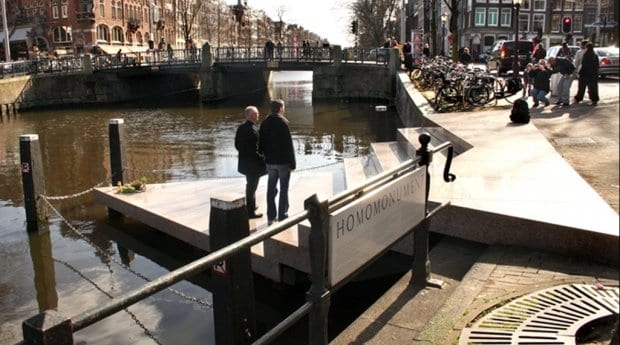
 Why you can trust Xtra
Why you can trust Xtra